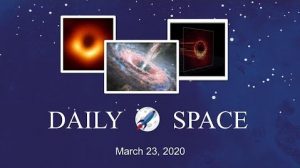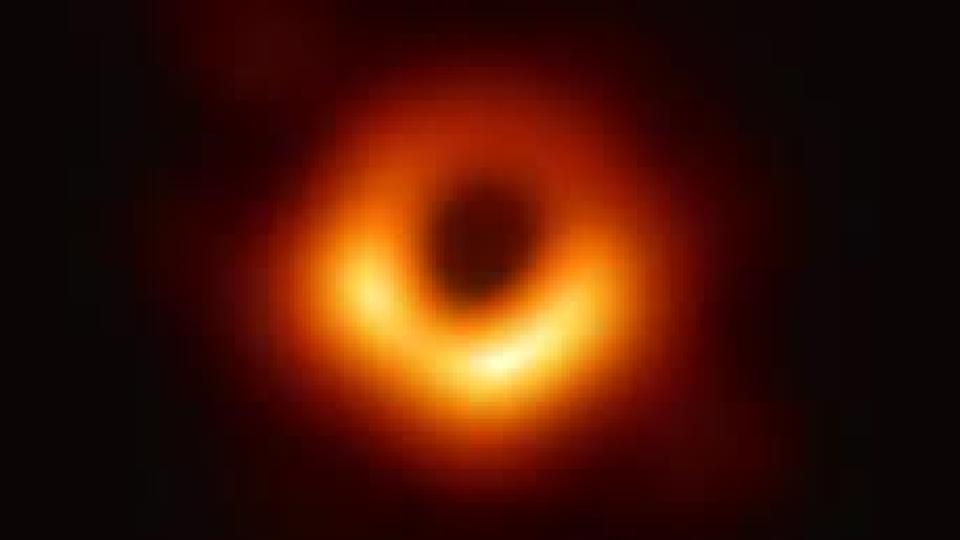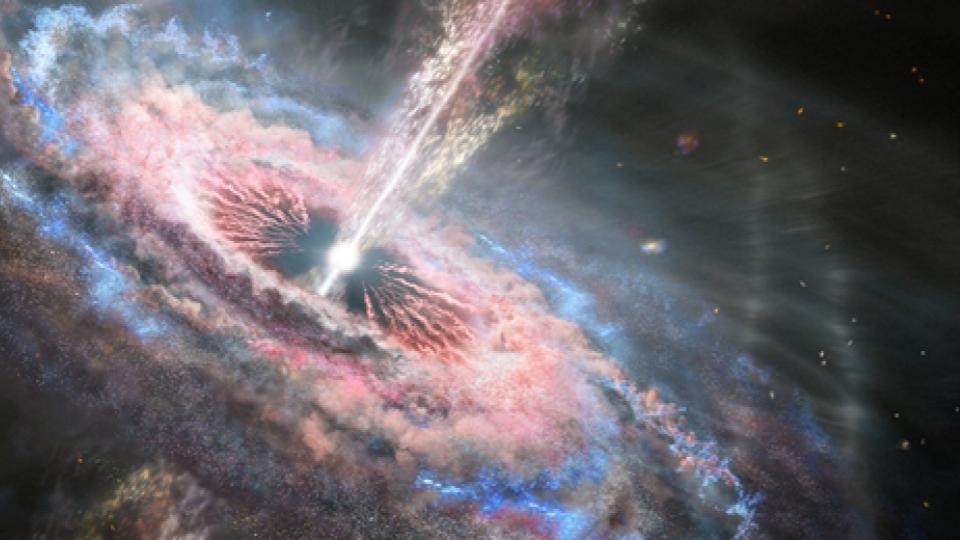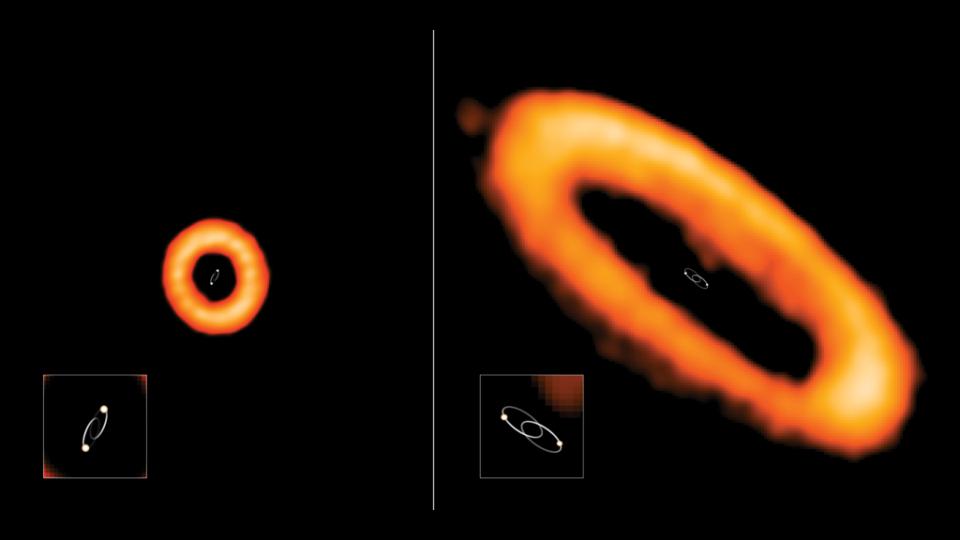
Today’s stories cover getting razor-sharp black hole Image using photon rings and future tech, detecting the powerful jets and winds produced by quasars in the galaxy, taking better images of Earth-like planets around other stars with upgraded adaptive optics, and watching the strange orbits of planets in orbit around binary stars.
Links
Black Hole Imaging
- Research Team Discovers Path to Razor-Sharp Black Hole Images (IAS)
- The Black Hole Is the Atom of the 21st Century (IAS)
Quasar wind in the galaxy
- Quasar tsunamis rip across galaxies (Hubble Space Telescope)
Using adaptive optics to take better images
- Snapping A Space Shot (UC Santa Barbara)
“Tatooine” planetary disks
Transcript
This is the Daily Space for today, Monday, March 23, 2020.
Welcome to the the Daily Space, I am your host, Dr Pamela Gay, and I am here to put science in your brain. Most Mondays through Fridays either I or my co-host Annie Wilson will be here, bringing you a quick run down of all that is new in space and astronomy.

Scientists have obtained the first image of a black hole, using Event Horizon Telescope observations of the center of the galaxy M87. The image shows a bright ring formed as light bends in the intense gravity around a black hole that is 6.5 billion times more massive than the Sun. This long-sought image provides the strongest evidence to date for the existence of supermassive black holes and opens a new window onto the study of black holes, their event horizons, and gravity. CREDIT: Event Horizon Telescope Collaboration.
Hello and Welcome to Monday. And I am here to tell you this Monday is lit.
Well, maybe not really, but our first story describes how we can understand the light disc around black holes in a new and truly spectacular way.
Last year the Event Horizon Telescope people shared the highest resolution image ever acquired of the region surrounding a black hole. This fuzzy orange donut shows us how light and hot light-emitting material swarms the Super-massive Black Hole in the core of the galaxy M87. Over the past year, a lot of folks have asked us to try and explain the asymmetric orange blob, and we’ve done our best, but it turns out that if an image causes 100 questions, a video may answer a 1000.
A team led by Michael Johnson of the Harvard Center for Astrophysics has modeled how light shining toward a black hole, but with bad aim that causes it to miss the black hole, can get bent to trace out rings and arcs of light. Their video, which you can see in the show notes on our site, DailySpace.org, looks out how closer-in paths lead to sharper lines, as trapped light follows close-in orbits, while a fuzzy outer glow comes for the lazier paths of less on-target light. These paths are called photon rings. Since light that passes close to the star has less distance to cover, this light may swing wide around the black hole numerous times before traveling to the observer, creating the bright rings seen in this simulation. Light further out, with larger orbits that take longer to travel, will have been retraced fewer times, creating fainter and fuzzier appearing rings.
While these fine structures can’t be seen in the fuzzy donut from the Event Horizon Telescope, there is the possibility of obtaining images that can see them with near future technology. In the article on this research published in Science Advances, the team describes how two radio telescopes, spread between our planet’s surface and orbit, would have sufficient resolution to map out these delicate structures and reveal the nature of a black hole. It turns out simple factors like how fast a black hole is spinning can have major relativistic effects on how light near the black hole travels, and some day, we may be able to image the stack rings of light around a black hole to study otherwise unmeasurable characteristics of these light-eating dense objects.
We can’t stress this enough – Black holes themselves do not shine light. The blackness we see in the Event Horizon Image is the shadow in space where a black hole says to the light that gets too close “Thou shall not pass” and then traps that light forever within its Schwartzschild radius.
While Black Holes don’t emit light, the material that is falling toward them can become extraordinarily dense, light up with its own nuclear reactions, and radiate massive quantities of light. This material, called an accretion disk, is responsible for the bright light coming from quasars and other kinds of active galaxies. It is also responsible for a whole lot of misleading headlines, including the headline for our next story, “Blistering radiation from active black hole snowplows immense amounts of mechanical energy through space.” To be clear – radiation … which is a fancy word for light… is responsible for any energy redistribution discussed in the next few minutes.

CREDITS: NASA, ESA, and J. Olmsted (STScI)
Astronomers using the Hubble Space Telescope to study quasar light and then working to model it using computers have published a series of 6 research papers in the Astrophysical Journal Supplements. They describe how this immensely energetic disc can drive the formation of powerful jets that push out through intergalactic space, and also generate a quasar wind inside the galaxy, much like our own star’s solar wind, that pushes material outwards. These jets and winds dump more energy than any other phenomena – even more than Gamma Ray Bursts. This has the effect of pushing back inner material in the galaxy and damping star formation, and pushing back on surrounding extra galactic material slows the growth of the galaxy. This research starts to finally show physics-linkages between galaxy size, black hole size, and dynamics, by following the energy interactions while a galaxy grows. It also hints at limiting factors on how galaxies can grow. This is just a start – but it’s a 6-paper start! We look forward to seeing how this research defines the reasons we see the size of a supermassive black hole correlated to a galaxy’s spheroid’s size.
We’re already starting to see the flow of news slow down as faculty all around the world struggle to figure out how to teach online, and delays come in as folks set up their computers from work on random surfaces in their home. Tomorrow, Pamela will be doing a round up of COVID-19 related science impacts we’re already seeing. For now, we’re just going to mention a few quick notes that under more normal times might get skipped over.

Researchers at the University of California at Santa Barbara are developing new detectors that cram more light sensing pixels into tiny spaces than prior detectors have been able to. These powerful new ultra-sensitive superconducting photon sensors, called MKIDs, have been tested using the Palomar observatory’s 200-inch telescope and will soon be installed on the 8-meter Subaru Telescope in Hawaii. It is hoped their great speed and capabilities will improve the quality of the telescope’s adaptive optics, allowing it to obtain higher resolution images on Earth than has previously been possible. With better sensors and better adaptive optics, they are hoping to better image Earth-sized planets in the habitable zone of alien stars. This work is still in its early days, but they believe they will one day be able to detect and characterize temperate, Earth-sized planets around nearby, low mass stars using ground-based massive telescopes.

CREDIT: ALMA (ESO/NAOJ/NRAO), I. Czekala and G. Kennedy; NRAO/AUI/NSF, S. Dagnello
And in one final bit of planetary news, astronomers have looked at a dozen planetary systems that have formed around binary stars. Called “Tatooine” systems, these systems exhibit some neat relationships between the stars’ orbits and the planets’ orbits. The illustration that accompanied this story may mislead folks. In general, the planets orbit in circles, but those circles look like ovals when you rotate the planet’s orbit relative to the star’s orbit. And this lack of alignment is exactly what happens in systems where the stars have longer orbits. This means that in systems where the planets are orbiting in and out of the sky – toward and away from us – we will observe planets going in a polite circle on the sky when the orbit is long [LEFT IMAGE]. This was seen for HD 9880 B and it’s 315 day orbit. In a system that has the stars still orbiting toward and away from us but in a shorter orbit, the planets will also orbit toward and away from us, nicely aligned [RIGHT IMAGE], as is seen in AK Scotii, where the stars orbit in 13.6 days.
Alright – that’s all we’ve got. Tomorrow Pamela will be back, with more science. But that rounds out our show for today.
<———————>
As part of helping keep us all occupied in these really weird times, we’re going to be hosting a lot of additional content on our Twitch channel, and we want to remind you that CosmoQuest has an active community on Discord where you can talk science and even find other people to join you in playing some online games. You can find links to everything that is going on at CosmoQuest.org.
Thank you all for listening. Today’s script was written by Pamela Gay, and the Daily Space is produced by Susie Murph. The Daily Space is a product of the Planetary Science Institute, a 501(c)3 non profit dedicated to exploring our Solar System and beyond. We are here thanks to the generous contributions of people like you. The best way you can support us is through Patreon.com/cosmoquestx Like us? Please share us! You never know whose life you can change by adding a daily dose of science.


 We record most shows live, on Twitch. Follow us today to get alerts when we go live.
We record most shows live, on Twitch. Follow us today to get alerts when we go live.